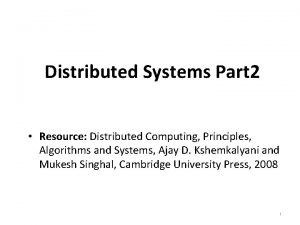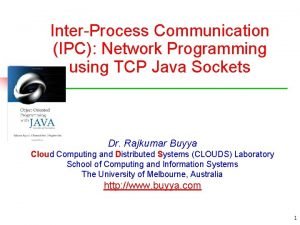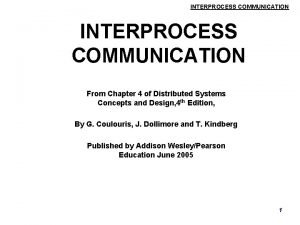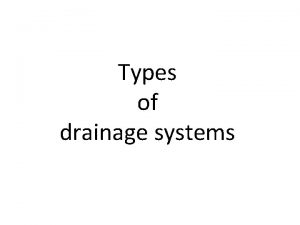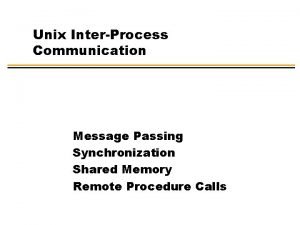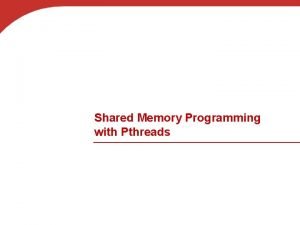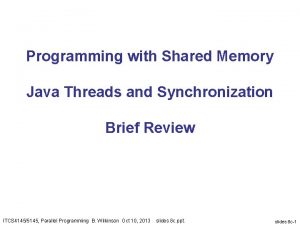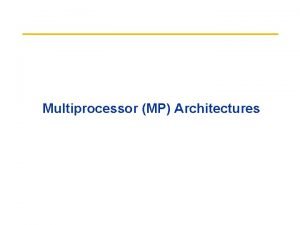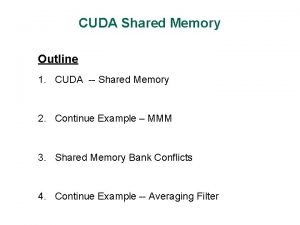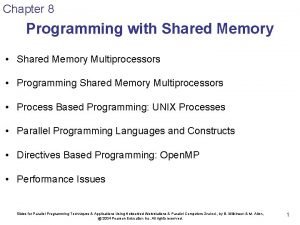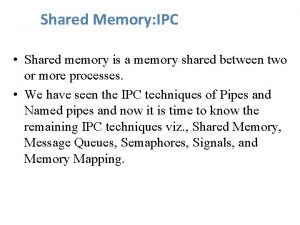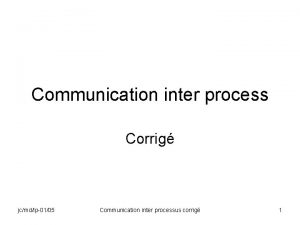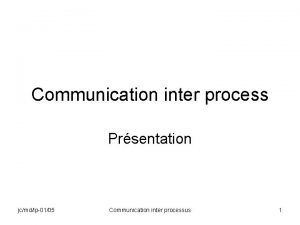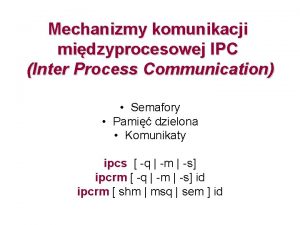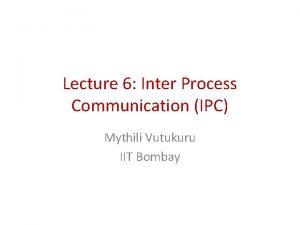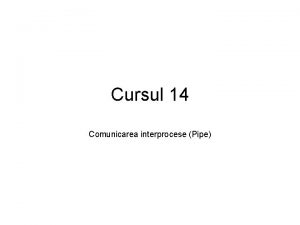Inter Process Communication IPC PIPE FIFO SHARED MEMORY


















- Slides: 18

Inter Process Communication (IPC) • PIPE • FIFO • SHARED MEMORY • MESSAGE QUEUE

Pipes • Acts as a conduit allowing two processes to communicate • Issues – Is communication unidirectional or bidirectional? – In the case of two-way communication, is it half or full-duplex? – Must there exist a relationship (i. e. parent-child) between the communicating processes? – Can the pipes be used over a network?

Ordinary Pipes • Ordinary Pipes allow communication in standard producer-consumer style • Producer writes to one end (the write-end of the pipe) • Consumer reads from the other end (the read-end of the pipe) • Ordinary pipes are therefore unidirectional • Require parent-child relationship between communicating processes

Ordinary Pipes Fd(0) : read side/ input side Fd(1) : write side / output side

Named Pipes • Named Pipes are more powerful than ordinary pipes • Communication is bidirectional • No parent-child relationship is necessary between the communicating processes • Several processes can use the named pipe for communication • Provided on both UNIX and Windows systems

Producer-Consumer Problem A Shared Memory Approach • Paradigm for cooperating processes, producer process produces information that is consumed by a consumer process. – unbounded-buffer places no practical limit on the size of the buffer. – bounded-buffer assumes that there is a fixed buffer size.

Bounded-Buffer – Shared-Memory Solution • Shared data #define BUFFER_SIZE 10 Typedef struct {. . . } item; item buffer[BUFFER_SIZE]; int in = 0; int out = 0; • Solution is correct, but can only use BUFFER_SIZE-1 elements

Bounded-Buffer – Producer Process item next. Produced; while (1) { /* Produce an item */ while (((in + 1) % BUFFER_SIZE) == out) ; /* do nothing – no free buffers*/ buffer[in] = next. Produced; in = (in + 1) % BUFFER_SIZE; }

Bounded-Buffer – Consumer Process item next. Consumed; while (1) { while (in == out) ; /* do nothing – nothing to consume */ // remove an item from the buffer } next. Consumed = buffer[out]; out = (out + 1) % BUFFER_SIZE;

Examples of IPC Systems -POSIX • POSIX Shared Memory • Process first creates shared memory segment – segment id = shmget(IPC PRIVATE, size, S IRUSR | S IWUSR); • Process wanting access to that shared memory must attach to it – shared memory = (char *) shmat(id, NULL, 0); • Now the process could write to the shared memory – sprintf(shared memory, "Writing to shared memory"); • When done a process can detach the shared memory from its address space – shmdt(shared memory);

Interprocess Communication – Message Passing • Mechanism for processes to communicate and to synchronize their actions Action without sharing same address space. Eg chat server. • IPC facility provides two operations: – send(message) – message size fixed or variable – receive(message) • If P and Q wish to communicate, they need to: – establish a communication link between them – exchange messages via send/receive

Direct Communication • Processes must name each other explicitly: – send (P, message) – send a message to process P – receive(Q, message) – receive a message from process Q • Properties of communication link – Links are established automatically – A link is associated with exactly one pair of communicating processes – Between each pair there exists exactly one link – The link may be unidirectional, but is usually bidirectional

This scheme exhibits symmetric addressing scheme. A variant of this scheme employ asymmetry in addressing. Here only sender names the recipient; the recipient not required to name the sender – send (P, message) – send a message to process P – receive(id, message) – receive a message from any process; the variable id is set to the name of the process with which communication has taken place. What is the problem with this scheme?

Indirect Communication • Messages are directed and received from mailboxes (also referred to as ports) – Each mailbox has a unique id – Processes can communicate only if they share a mailbox • Properties of communication link – Link established only if processes share a common mailbox – A link may be associated with many processes – Each pair of processes may share several communication links – Link may be unidirectional or bi-directional

Indirect Communication • Operations – create a new mailbox – send and receive messages through mailbox – destroy a mailbox • Primitives are defined as: send(A, message) – send a message to mailbox A receive(A, message) – receive a message from mailbox A

Indirect Communication • Mailbox sharing – P 1, P 2, and P 3 share mailbox A – P 1, sends; P 2 and P 3 receive – Who gets the message? • Solutions – Allow a link to be associated with at most two processes – Allow only one process at a time to execute a receive operation – Allow the system to select arbitrarily the receiver. Sender is notified who the receiver was. A mailbox may be owned either by a process or by the OS.

Synchronization • Message passing may be either blocking or non-blocking • Blocking is considered synchronous – Blocking send has the sender block until the message is received – Blocking receive has the receiver block until a message is available • Non-blocking is considered asynchronous – Non-blocking send has the sender send the message and continue – Non-blocking receive has the receiver receive a valid message or null

Examples of IPC Systems - Mach • Mach communication is message based – Even system calls are messages – Each task gets two mailboxes at creation- Kernel and Notify – Only three system calls needed for message transfer msg_send(), msg_receive(), – Mailboxes needed for commuication, created via port_allocate()
 Mutual exclusion in distributed system tutorialspoint
Mutual exclusion in distributed system tutorialspoint Symmetric shared memory architecture
Symmetric shared memory architecture Interprocess communication shared memory
Interprocess communication shared memory Ipc java
Ipc java Request reply protocol in distributed system
Request reply protocol in distributed system Double pipe heat exchanger calculations
Double pipe heat exchanger calculations Two pipe plumbing system
Two pipe plumbing system Contoh soal process costing metode fifo
Contoh soal process costing metode fifo Process costing fifo vs weighted average
Process costing fifo vs weighted average Posix shared memory synchronization
Posix shared memory synchronization Pthreads tutorial
Pthreads tutorial Shared memory consistency models a tutorial
Shared memory consistency models a tutorial Java shared memory between threads
Java shared memory between threads Share a single centralized memory
Share a single centralized memory Symmetric shared memory architecture
Symmetric shared memory architecture Cuda bank conflict
Cuda bank conflict Symmetric shared memory architecture
Symmetric shared memory architecture Distributed shared memory
Distributed shared memory Shared memory approaches in distributed system
Shared memory approaches in distributed system
